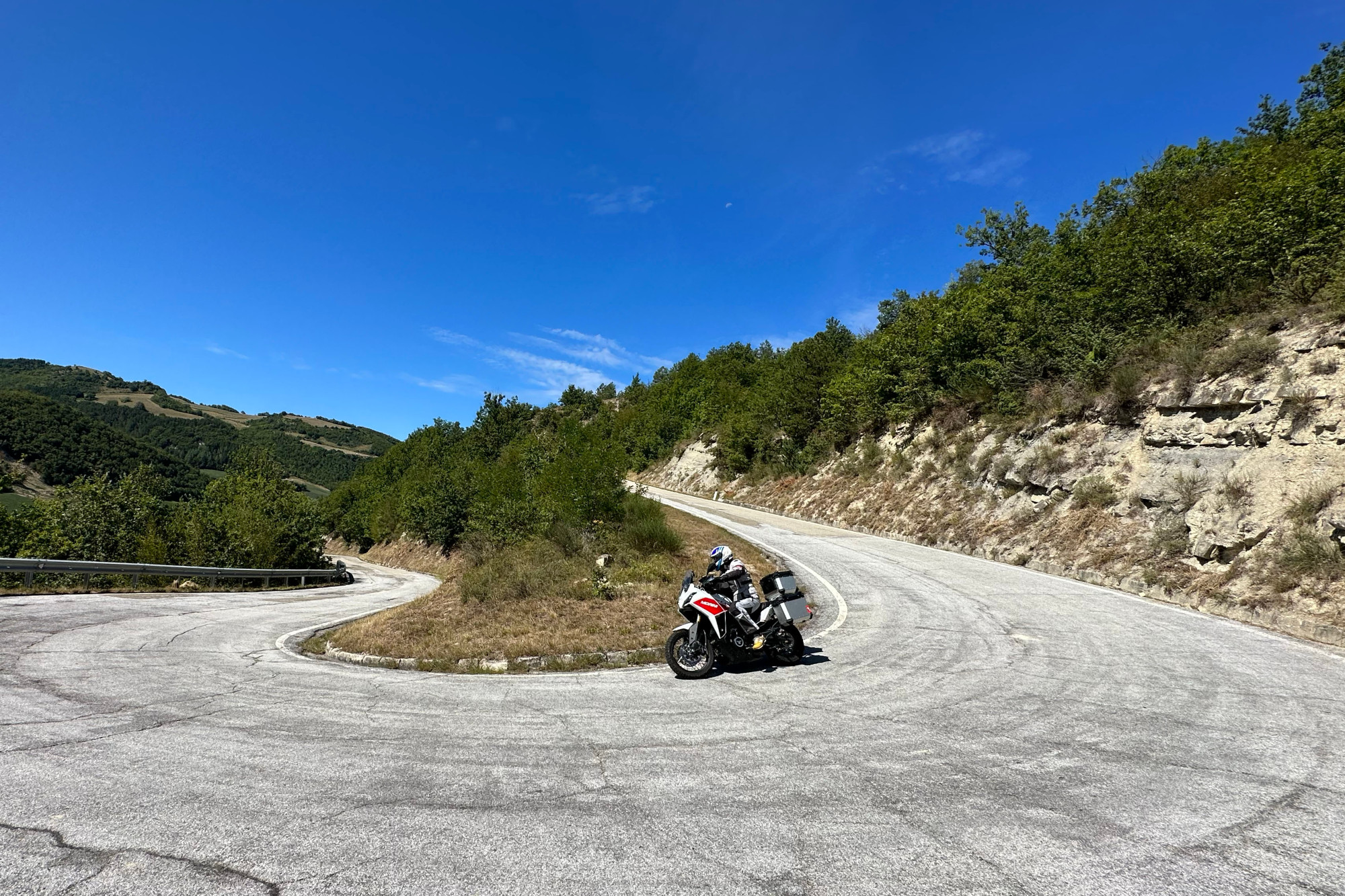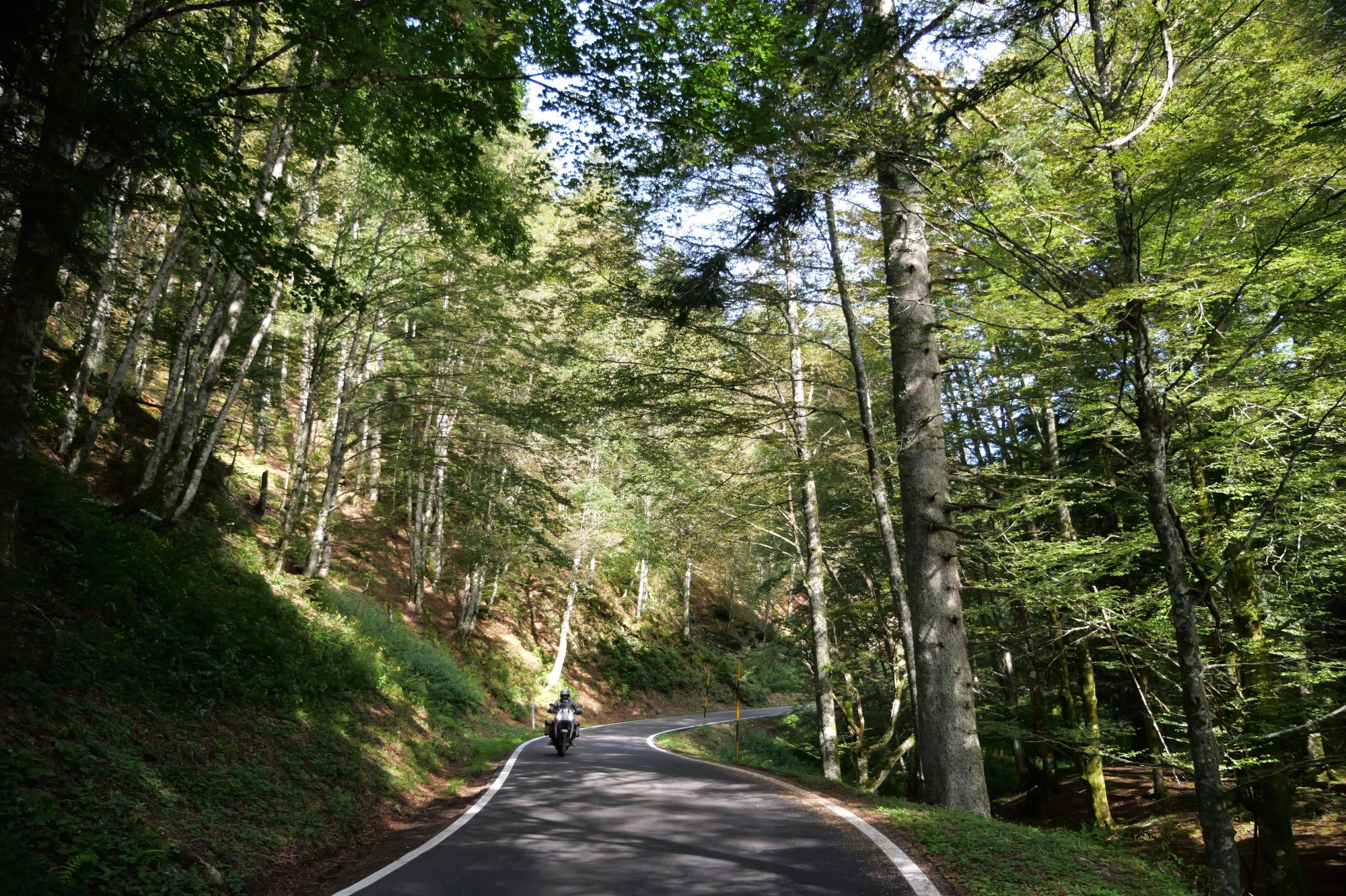
Itinerary: Firenze (0 km), Pontassieve (10 km), Rufina (18 km), Dicomano (28 km), San Godenzo (39 km), Valico dei Tre Faggi (50 km), Premilcuore (64 km), Strada San Zeno (75 km), Galeata (80 km), Santa Sofia (87 km), Passo del Carnaio (99 km), San Piero in Bagno (103 km), Sarsina (122 km), Mercato Saraceno (130 km), Passo del Borbotto (136 km), Perticara (140 km), Secchiano (151 km), San Leo (157 km), San Marino (180 km), Rimini (206 km)
Duration: 48 hours
Total length: 206 km
Difficulty: easy
When to start: From March to November
Bikes: all types
There is something magical in imagining riding a motorbike along the route of the first stage of the Tour de France 2024, a journey that starts from the heart of Florence and winds through the hills of the Apennines to the sea of Rimini. A 200 km route that is not only a challenge for cyclists, but an unforgettable experience for those who love the road and the landscapes.
The journey begins at Parco delle Cascine, where the noise of the engine mixes with the silence of a place that is still quiet, far from the chaos of the event. After parking the motorbike, you get lost in the alleys of Florence, between Piazza della Repubblica and Ponte Vecchio, while the Duomo stands majestically on the horizon. A short climb takes you to Piazzale Michelangelo, from which the city shows itself in all its beauty. It is here that the desire to leave is ignited, to leave behind the Renaissance charm to immerse yourself in nature. From Florence, you descend towards Bagno a Ripoli, where the route officially begins. The road runs along the Arno river, with its soft curves and relaxing views. After Pontassieve, you leave the river to go up the Sieve, following an ancient proverb: “Arno does not grow if Sieve does not pour”. The motorbike seems to fly between the increasingly challenging curves as you approach the Muraglione Pass, one of the most iconic motorcycling locations in the Apennines.
At 907 metres above sea level, the Muraglione is a motorcycle icon with its history linked to Grand Duke Leopold II. State Highway SS67, with its sinuous curves and inviting hairpin bends, is a pleasure for those who are driving. A handful of kilometres from the summit is the detour onto Provincial Highway SP9ter, which, following the course of the Rabbi river, descends towards the medieval hamlet of Premilcuore, taking us into the heart of Romagna. The road that we follow now for about twenty kilometres, with its new asphalt surface put down especially for the great race, is, to say the least, perfect all the way to the finish line. Premilcuore is an ancient walled hamlet whose origins are lost in the mists of time, and that, along the course of the Rabbi, hides two wild and unique, magical places: the Sega waterfall, near the village, and just a few kilometres away in the Giumella area, the Grotta Urlante (the screaming cave).
It is by following the course of the river that, in about fifteen kilometers, you reach Strada San Zeno, from where the Forche road starts off; this is a part of the "Traversa di Romagna" that the Grand Duke Francesco Leopoldo II wanted in order to connect Bagno di Romagna and Rocca San Casciano in 1836. Thus, you cross the mountain to arrive at Galeata, in the Bidente Valley, decorated with the yellow colour of the race. It is along this ancient route that the Tour will pass through a bit of Santa Sofia to reach the beautiful curves of the Passo del Carnaio in San Piero in Bagno and the Savio Valley.
The journey continues towards Bagno di Romagna, famous for its Roman baths. From there, after passing San Piero in Bagno, the route follows the Savio river until it reaches Sarsina and then Mercato Saraceno, where, after crossing the river, the most challenging climb awaits us: the Borbotto. With gradients of up to 18%, it is a challenge that puts the motorbike and the rider to the test. At the top, a plaque commemorates Marco Pantani (an Italian road-racing cyclist), the “Pirate” who prepared for his legendary exploits on these roads.
After Perticara and Novafeltria, the profile of San Leo, with the magnificence of its fortress commissioned by Federico da Montefeltro, dominates the landscape. The road becomes narrower and more winding, with re-asphalted hairpin curves that now lead towards San Marino, the ancient Land of Liberty. Here, the air becomes fresher and silence reigns supreme, far from the chaos of the tourist centre, but here, finally, is the descent towards Rimini that provides the first view of the sea, an emotion that warms the heart after so many kilometres.
From 684 metres above sea level, the long, blue tongue of the sea that now stands out on the horizon is no longer the dream that the fast lanes of the downhill highway help to bring closer. Arriving in Rimini is like closing a circle that started along the Arno river from the heart of the Renaissance to reach the sea, passing through ancient hamlets, over legendary passes and roads that seem made especially for those who love to travel by motorbike. It is not just a route, but an experience that remains inside you with the memory of the beauty that has been with us so far on the curves of the Apennines, with the pleasure of discovering that bicycle and motorbike lovers have something more to share than just their two wheels.

